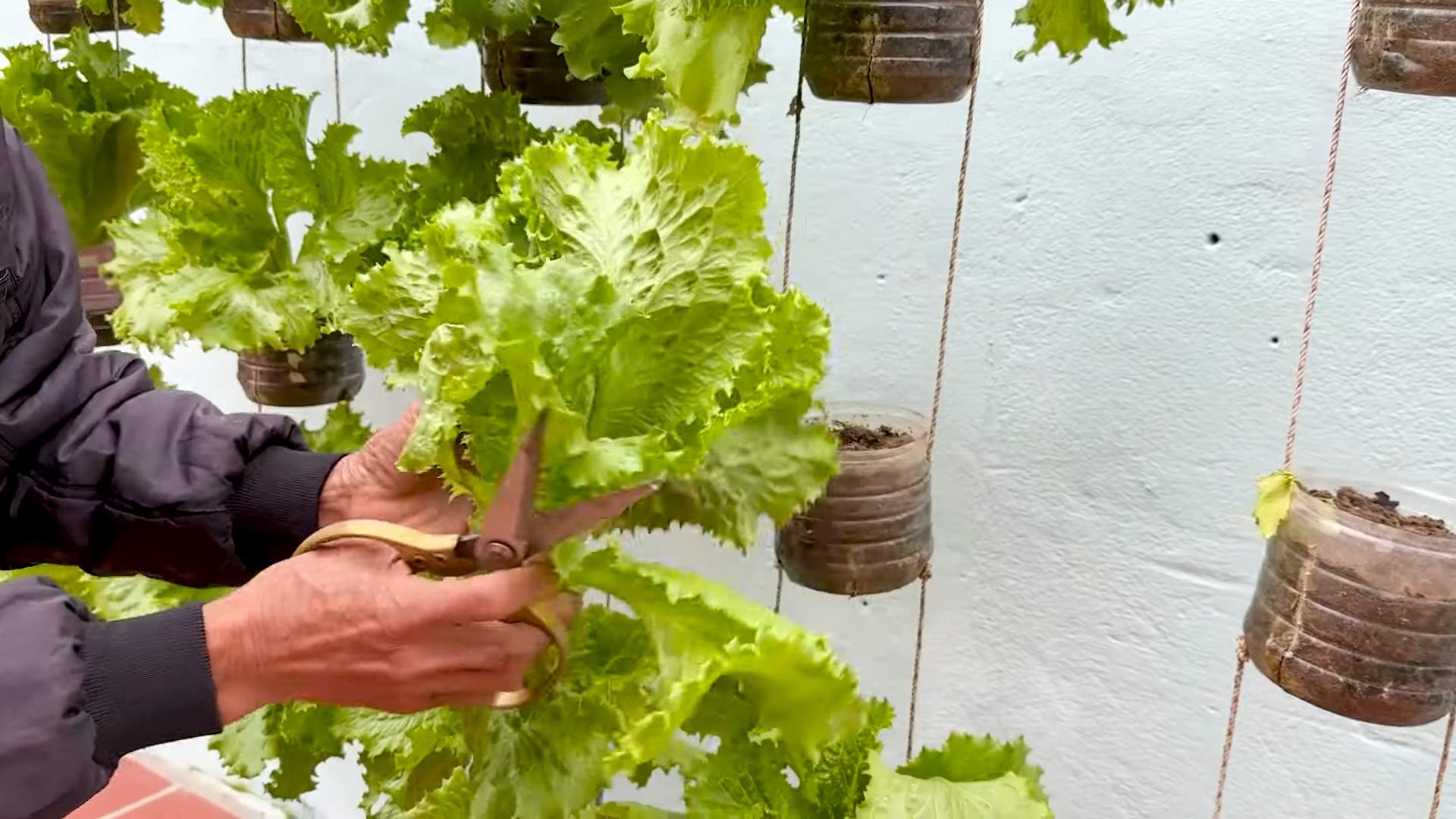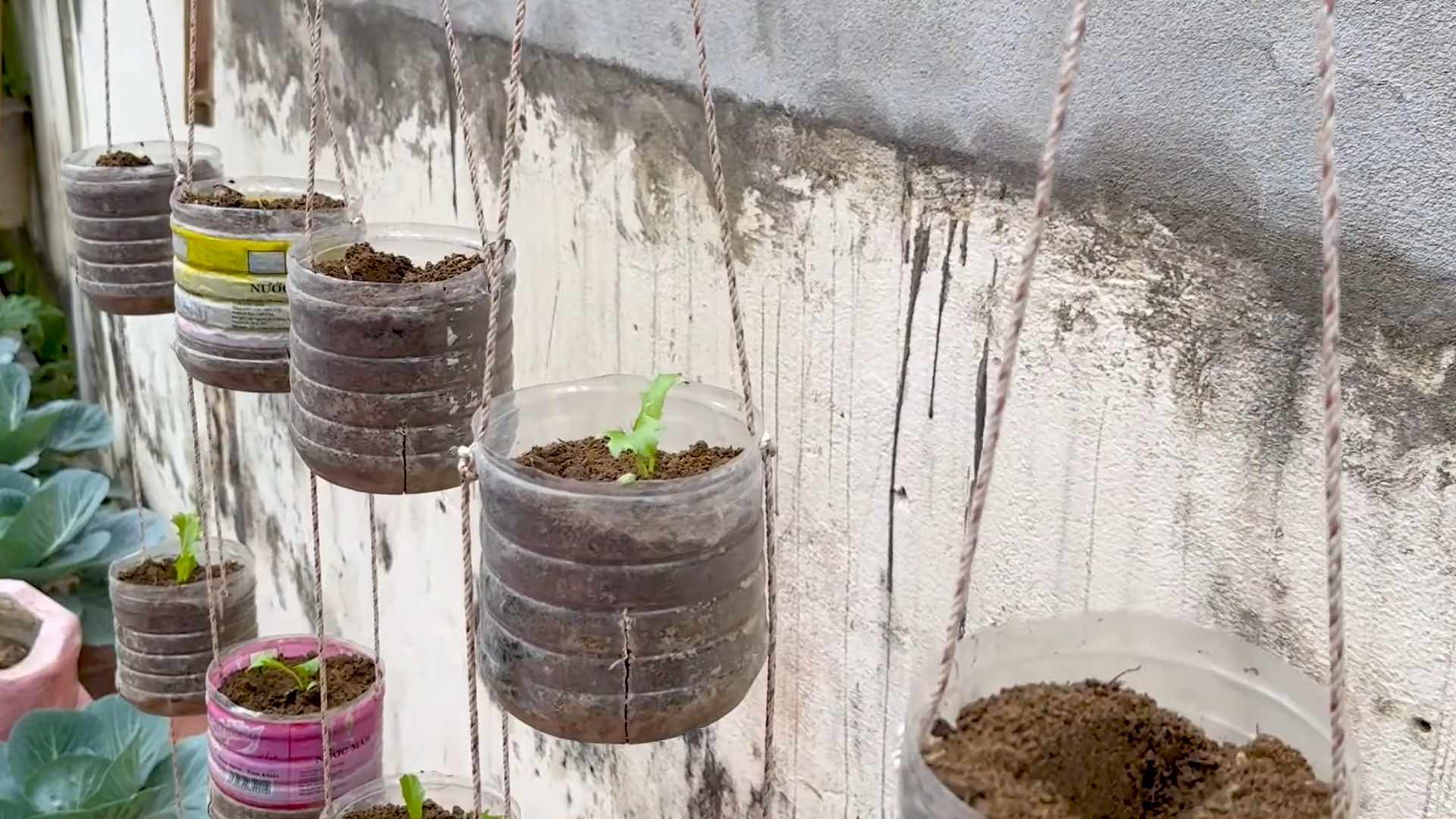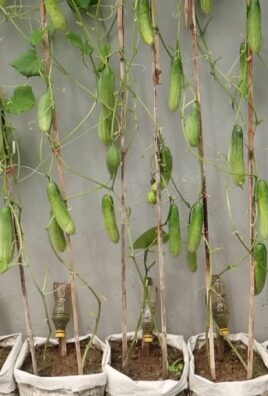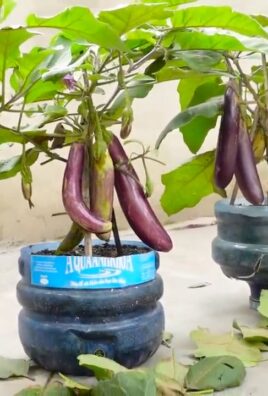Grow Lettuce at Home – imagine stepping outside your back door and snipping fresh, crisp lettuce for your salad, sandwich, or even a quick snack. No more trips to the grocery store for wilted, overpriced greens! For centuries, cultivating your own food has been a cornerstone of self-sufficiency and a connection to nature. From ancient Roman kitchen gardens to the victory gardens of wartime, growing your own produce has always been a way to ensure fresh, healthy food is available.
But let’s be honest, the idea of starting a garden can feel overwhelming. Where do you even begin? That’s where these simple, effective DIY tricks come in. I’m here to show you that you don’t need a sprawling farm or a green thumb to grow lettuce at home successfully. Whether you have a sprawling backyard, a sunny balcony, or just a windowsill, I’ll share easy-to-follow tips and hacks that will have you harvesting your own delicious lettuce in no time.
Why do you need these DIY tricks? Because store-bought lettuce often lacks flavor and nutrients, and let’s not forget the environmental impact of transportation and packaging. Plus, there’s nothing quite like the satisfaction of nurturing a plant from seed to table. So, let’s ditch the store-bought greens and embark on this exciting journey to grow your own fresh, flavorful lettuce at home!

Grow Your Own Delicious Lettuce: A Beginner’s Guide
Hey there, fellow gardening enthusiasts! Ever dreamt of having fresh, crisp lettuce right at your fingertips? Well, dream no more! Growing your own lettuce is surprisingly easy, even if you don’t have a sprawling garden. I’m going to walk you through everything you need to know to cultivate a thriving lettuce patch, whether you’re working with a balcony, a small backyard, or even just a sunny windowsill. Let’s get started!
Choosing Your Lettuce Varieties
First things first, let’s talk lettuce types! There’s a whole world of leafy greens out there, and picking the right varieties for your taste and growing conditions is key. Here’s a quick rundown of some popular choices:
* **Loose-leaf Lettuce:** These are the easiest to grow and harvest. They don’t form a head, so you can snip off leaves as needed. ‘Black Seeded Simpson’ and ‘Red Sails’ are great options.
* **Butterhead Lettuce:** Known for their soft, buttery texture and delicate flavor. ‘Buttercrunch’ and ‘Tom Thumb’ are classic choices.
* **Romaine Lettuce:** The star of Caesar salads! Romaine lettuce has a crisp texture and a slightly bitter flavor. ‘Paris Island Cos’ and ‘Little Gem’ are popular varieties.
* **Crisphead Lettuce:** These form tight, round heads like iceberg lettuce. They’re a bit more challenging to grow than other types, but the reward is worth it! ‘Great Lakes’ is a reliable choice.
Consider your climate when choosing your lettuce. Some varieties are more heat-tolerant than others. If you live in a warmer climate, look for heat-resistant varieties like ‘Sierra’ or ‘Nevada’.
Getting Started: Seeds vs. Seedlings
You have two main options for starting your lettuce garden: seeds or seedlings. Both have their pros and cons:
* **Seeds:** Starting from seed is more economical and gives you a wider variety of choices. However, it requires a bit more patience and attention.
* **Seedlings:** Seedlings are a great option if you’re short on time or want a head start. They’re already established, so you can transplant them directly into your garden.
I personally prefer starting from seed because I love the feeling of nurturing a plant from its earliest stages. But if you’re a beginner, seedlings can be a great way to get your feet wet.
Planting Your Lettuce
Now for the fun part: planting! Here’s a step-by-step guide to planting your lettuce, whether you’re starting from seed or seedlings:
Planting from Seed
1. **Prepare the soil:** Lettuce prefers well-drained soil that’s rich in organic matter. Amend your soil with compost or aged manure before planting. If you’re planting in containers, use a high-quality potting mix.
2. **Sow the seeds:** Lettuce seeds are tiny, so sow them thinly. Sprinkle the seeds over the soil surface and gently press them in. You can also create shallow furrows (about 1/4 inch deep) and sow the seeds in the furrows.
3. **Cover the seeds:** Lightly cover the seeds with soil or vermiculite.
4. **Water gently:** Water the soil gently to avoid disturbing the seeds. Use a watering can with a rose attachment or a spray bottle.
5. **Keep the soil moist:** Lettuce seeds need consistent moisture to germinate. Keep the soil moist but not soggy.
6. **Thin the seedlings:** Once the seedlings emerge and have a few true leaves, thin them out to give them enough space to grow. Space loose-leaf lettuce about 4-6 inches apart, butterhead and romaine lettuce about 8-10 inches apart, and crisphead lettuce about 12 inches apart.
Planting Seedlings
1. **Prepare the soil:** Just like with seeds, make sure your soil is well-drained and rich in organic matter.
2. **Dig holes:** Dig holes that are slightly larger than the root balls of your seedlings.
3. **Remove the seedlings from their containers:** Gently remove the seedlings from their containers, being careful not to damage the roots.
4. **Place the seedlings in the holes:** Place the seedlings in the holes and backfill with soil.
5. **Water thoroughly:** Water the seedlings thoroughly after planting.
6. **Space the seedlings:** Space the seedlings according to the variety you’re growing (see spacing recommendations above).
Caring for Your Lettuce
Once your lettuce is planted, it’s time to provide it with the care it needs to thrive. Here’s what you need to know:
1. **Watering:** Lettuce needs consistent moisture, especially during hot weather. Water deeply whenever the top inch of soil feels dry. Avoid overhead watering, as this can lead to fungal diseases.
2. **Fertilizing:** Lettuce is a light feeder, but it will benefit from occasional fertilization. Use a balanced fertilizer or a fertilizer specifically formulated for leafy greens. Follow the instructions on the fertilizer label.
3. **Weeding:** Keep your lettuce patch free of weeds. Weeds compete with lettuce for water and nutrients.
4. **Pest Control:** Lettuce can be susceptible to pests like aphids, slugs, and snails. Inspect your plants regularly and take action if you see any signs of infestation. You can use organic pest control methods like insecticidal soap or diatomaceous earth.
5. **Sunlight:** Lettuce needs at least 6 hours of sunlight per day. If you live in a hot climate, provide some afternoon shade to prevent the leaves from wilting.
Harvesting Your Lettuce
The best part of growing your own lettuce is, of course, harvesting it! Here’s how to harvest your lettuce for the best flavor and texture:
1. **Harvest loose-leaf lettuce:** You can start harvesting loose-leaf lettuce as soon as the leaves are large enough to eat. Simply snip off the outer leaves with scissors or a knife. The plant will continue to produce new leaves.
2. **Harvest butterhead and romaine lettuce:** Harvest butterhead and romaine lettuce when the heads are firm and well-formed. Cut the head at the base of the plant.
3. **Harvest crisphead lettuce:** Harvest crisphead lettuce when the heads are firm and tightly packed. Cut the head at the base of the plant.
4. **Harvest in the morning:** Harvest your lettuce in the morning, when the leaves are crisp and cool.
5. **Store your lettuce:** Store your lettuce in the refrigerator in a plastic bag or container. It will keep for several days.
Troubleshooting
Even with the best care, you might encounter some problems while growing your lettuce. Here are some common issues and how to address them:
* **Bolting:** Bolting is when lettuce plants send up a flower stalk and the leaves become bitter. This is usually caused by hot weather or stress. To prevent bolting, choose heat-resistant varieties, provide shade during hot weather, and water regularly.
* **Yellowing leaves:** Yellowing leaves can be caused by a variety of factors, including overwatering, underwatering, nutrient deficiencies, and pests. Check the soil moisture and nutrient levels and look for signs of pests.
* **Slugs and snails:** Slugs and snails can be a major problem for lettuce growers. They feed on the leaves, leaving holes and slime trails. You can control slugs and snails by handpicking them, using beer traps, or applying diatomaceous earth.
* **Aphids:** Aphids are small, sap-sucking insects that can weaken lettuce plants. You can control aphids by spraying them with insecticidal soap or releasing beneficial insects like ladybugs.
Extending Your Lettuce Season
Want to enjoy fresh lettuce all season long? Here are some tips for extending your lettuce season:
* **Succession planting:** Sow new lettuce seeds every few weeks to ensure a continuous harvest.
* **Plant in containers:** Containers are easier to move around, so you can protect your lettuce from extreme weather.
* **Use row covers:** Row covers can protect your lettuce from frost and pests.
* **Grow lettuce indoors:** You can grow lettuce indoors under grow lights during the winter months.
Enjoying Your Homegrown Lettuce
Now that you’ve successfully grown your own lettuce, it’s time to enjoy the fruits (or rather, leaves!) of your labor. Here are some ideas for using your homegrown lettuce:
* **Salads:** The most obvious choice! Use your lettuce as the base for a variety of salads.
* **Sandwiches and wraps:** Add lettuce to sandwiches and wraps for extra crunch and flavor.
* **Lettuce wraps:** Use large lettuce leaves as wraps for fillings like ground meat, vegetables, or tofu.
* **Soups and stews:** Add chopped lettuce to soups and stews for a fresh, vibrant flavor.
* **Juices and smoothies:** Blend lettuce into juices and smoothies for a healthy boost.
Growing your own lettuce is a rewarding experience that will provide you with fresh, delicious greens all season long. With a little bit of care and attention, you can enjoy a thriving lettuce patch, no matter how much space you have. Happy gardening

Conclusion
So, there you have it! Growing lettuce at home, even if you’ve never considered yourself a gardener, is surprisingly simple and incredibly rewarding. We’ve walked you through the process, highlighting the ease and accessibility of this DIY project. But why is this a must-try? Beyond the sheer satisfaction of harvesting your own food, growing your own lettuce offers a flavor profile that store-bought varieties simply can’t match. Imagine crisp, vibrant leaves, bursting with freshness, ready to elevate your salads, sandwiches, and wraps. You’ll also be reducing your carbon footprint by eliminating transportation costs and packaging waste. Plus, you’ll know exactly what’s going into your food – no mystery chemicals or preservatives!
But the benefits don’t stop there. Think of the money you’ll save by not constantly buying lettuce at the grocery store. And let’s not forget the therapeutic aspect of gardening. Spending time nurturing your lettuce plants can be a wonderfully relaxing and stress-relieving activity. It’s a chance to connect with nature and appreciate the simple beauty of growth.
Ready to take your lettuce game to the next level? Consider experimenting with different varieties. Romaine, butterhead, loose-leaf – the possibilities are endless! You can also try succession planting, sowing new seeds every few weeks to ensure a continuous harvest throughout the growing season. If you’re short on space, vertical gardening is a fantastic option. Use stacked planters or hanging baskets to maximize your yield. And for those in colder climates, consider using a cold frame or greenhouse to extend your growing season.
Don’t be intimidated by the idea of gardening. Growing lettuce at home is a forgiving and beginner-friendly project. With a little bit of sunlight, water, and care, you’ll be enjoying fresh, delicious lettuce in no time. We encourage you to give it a try!
We’re confident that you’ll be amazed by the results. And once you’ve experienced the joy of harvesting your own lettuce, you’ll never want to go back to store-bought again. So, grab your seeds, prepare your soil, and get ready to embark on this exciting gardening adventure.
We’d love to hear about your experiences! Share your photos, tips, and tricks in the comments below. Let’s create a community of home lettuce growers and inspire others to discover the joys of fresh, homegrown produce. What are you waiting for? Start growing lettuce at home today!
Frequently Asked Questions (FAQ)
What kind of lettuce is easiest to grow for beginners?
Loose-leaf varieties like Black Seeded Simpson or Salad Bowl are generally considered the easiest for beginners. They mature quickly, are relatively tolerant of different conditions, and you can harvest individual leaves as needed, rather than waiting for the entire head to mature. This “cut-and-come-again” method extends your harvest period.
How much sunlight does lettuce need?
Lettuce thrives in full sun (6-8 hours of direct sunlight per day), but it can also tolerate partial shade, especially in hotter climates. If you live in a region with intense summer heat, providing some afternoon shade can prevent your lettuce from bolting (going to seed prematurely), which makes the leaves bitter.
What kind of soil is best for growing lettuce?
Lettuce prefers well-drained, fertile soil that is rich in organic matter. Amend your soil with compost or well-rotted manure before planting to improve its structure and nutrient content. A slightly acidic to neutral soil pH (around 6.0 to 7.0) is ideal. You can test your soil pH with a home testing kit or by sending a sample to your local agricultural extension office.
How often should I water my lettuce?
Lettuce needs consistent moisture to thrive. Water deeply and regularly, especially during hot, dry weather. Aim to keep the soil consistently moist but not waterlogged. Overwatering can lead to root rot. Check the soil moisture by sticking your finger about an inch deep. If it feels dry, it’s time to water.
How do I prevent lettuce from bolting?
Bolting is a common problem, especially in hot weather. To prevent bolting, choose bolt-resistant varieties, provide afternoon shade, and water regularly. Harvesting outer leaves frequently can also help delay bolting. If your lettuce does start to bolt, you can still harvest the leaves, but they may become bitter.
When is the best time to harvest lettuce?
Harvest lettuce in the morning, when the leaves are crisp and cool. For loose-leaf varieties, you can harvest individual leaves as needed, starting with the outer leaves. For head lettuce, harvest when the head is firm and well-formed. Cut the head at the base with a sharp knife.
Can I grow lettuce in containers?
Yes, lettuce grows very well in containers. Choose a container that is at least 6 inches deep and has drainage holes. Use a good-quality potting mix and water regularly. Container-grown lettuce may need more frequent watering than lettuce grown in the ground.
What are some common pests and diseases that affect lettuce?
Common pests that affect lettuce include aphids, slugs, and snails. You can control aphids with insecticidal soap or by handpicking them off the plants. Slugs and snails can be controlled with beer traps or by handpicking them at night. Common diseases that affect lettuce include downy mildew and powdery mildew. Prevent these diseases by providing good air circulation and avoiding overhead watering.
Can I grow lettuce indoors?
Yes, you can grow lettuce indoors, especially during the winter months. You’ll need a sunny windowsill or a grow light to provide adequate light. Choose a compact variety and use a good-quality potting mix. Water regularly and fertilize every few weeks.
How long does it take for lettuce to grow?
The time it takes for lettuce to grow depends on the variety and growing conditions. Loose-leaf varieties typically mature in 30-45 days, while head lettuce varieties may take 60-80 days. You can start harvesting loose-leaf lettuce as soon as the leaves are large enough to eat.
What fertilizer should I use for lettuce?
Lettuce benefits from a balanced fertilizer that is rich in nitrogen, phosphorus, and potassium. You can use a liquid fertilizer or a slow-release granular fertilizer. Follow the instructions on the fertilizer package. Avoid over-fertilizing, as this can lead to leggy growth and bitter leaves.
Can I save lettuce seeds?
Yes, you can save lettuce seeds, but it requires allowing the lettuce to bolt and go to seed. This process can take several weeks or months. Once the seed heads are dry and brown, you can harvest the seeds and store them in a cool, dry place. Keep in mind that lettuce seeds may not come true to type, especially if you are growing multiple varieties.
Is growing lettuce at home organic?
Growing lettuce at home allows you to control the inputs and ensure it’s organic. By using organic soil amendments, avoiding synthetic pesticides and fertilizers, you can grow truly organic lettuce. Look for certified organic seeds to ensure the entire process is organic.





Leave a Comment